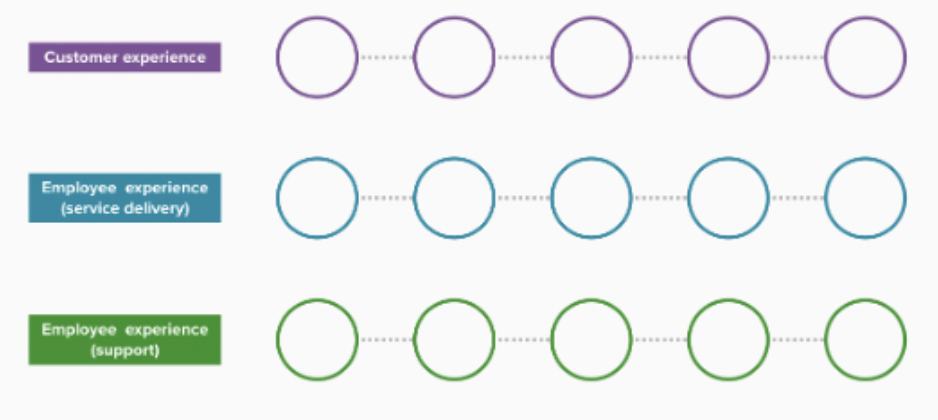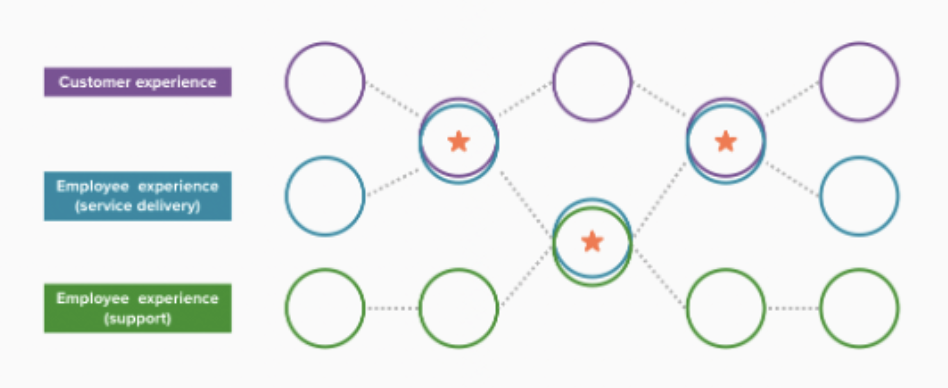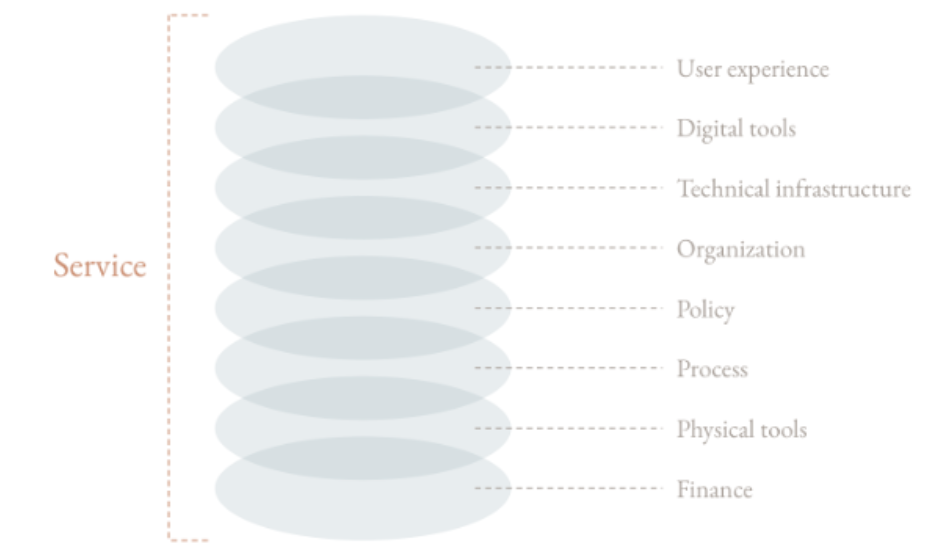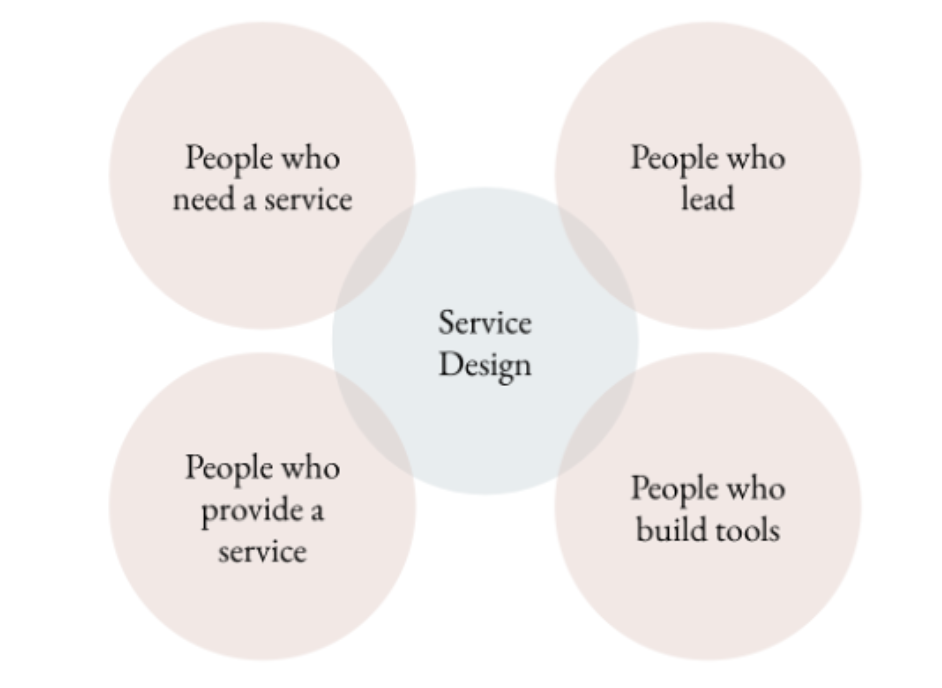What is service design?
Understanding Service Design
Service design looks at the total picture of what is required for an organization to deliver a service. It designs the way that people, processes, and tools come together to create a desired outcome. Sometimes, services exist to serve customers external to the organization providing the service, for example, passengers at an airport. Oftentimes, customers are internal to the organization, such as business units in an energy company.
BELOW THE SURFACE
Much of what makes services possible happens behind the scenes. Most of the people, processes, and tools involved are invisible to the customer, and sometimes even to the employees working within the service. Service designers dive below the surface to identify and understand all of the moving pieces and how they combine to create a service. This includes things like people, technical infrastructure, policies, physical tools, goods, and the places where services are delivered. This global picture allows us to clearly identify opportunities for improvement or innovation.
The totality of a service isn't tangible and can sometimes be hard to imagine. This can make services difficult to understand and work with. We use visual tools like service design blueprints, which show all of the layers of moving parts that make up a service, to help us understand, analyze, and communicate about the service.
INTERSECTING HUMAN EXPERIENCES
Typically, multiple people are involved in a service, including customers and employees. We equally consider the customer's experience using the service and the employee's experience delivering it. While service design looks at each of their independent experiences, it is focused on how they interact with one another throughout the service.
This ensures that both the customer and employees are prepared to have positive, successful interactions. In turn, this creates a better customer experience, better days at work, and more effective service delivery. Service design often leverages other design specialties, such as user experience design, to focus elements of the users' experiences.
SCOPE OF SERVICE DESIGN COMPARED TO OTHER TYPES OF DESIGN
While service design is human centred, it looks beyond the tangible human interactions to consider the broader conditions required for successful service delivery. For example, when looking at a ride hailing service, user experience design may be focused on how a rider interacts with an application to input their desired destination, confirm their ride, and receive information about their driver.
In contrast, service design looks at user experience and other processes or systems that are required to render the service to all customers, such as:
The drivers' experience using an app to receive work and get paid
The riders' experience using an app to hail and pay for rides
How to ensure that there are drivers available to meet fluctuating demand
How to match drivers and riders appropriately, etc.
Service design is focused on how multiple moving pieces come together to achieve an outcome and create value. We work with subject matter experts on each of those pieces.
Doing Service Design
USE A VARIETY OF MEDIUMS
Doing service design is a bit of a balancing act. As service designers, we coordinate:
The needs of the people interacting with the service
The needs of the business providing the service
The tools and props that support the service
To do this, we leverage a variety of practices and mediums that you may be familiar with, such as employee experience, technical infrastructure, policy, digital tools, organizational strategy, financial process, etc. A service is ultimately what happens when we organize all of these different pieces in a particular way.
CO-DESIGN AND COLLABORATION
Service designers are not experts in most of the mediums that we work with, but we skillfully engage others to leverage their expertise throughout the design process. We bring expertise in understanding people, making sense of complexity, identifying opportunities, and facilitating collaboration. We engage with diverse stakeholders throughout the process in different ways. Sometimes, we consult them and sometimes they are alongside us doing the work.
Co-design with customers and employees is essential to create services that are useful and usable. They are the experts on their needs and the day-to-day operations of a service. We gain so much insight by collaborating closely with them throughout the process. Consultation with executives and leaders enables us to ensure that the services we are building are aligned with the organization's larger strategic goals. This collaboration also enables us to understand the organizational context and create conditions for the service to be successful.
Oftentimes, service delivery benefits from custom tools. We work with technical experts in a variety of fields to build the tools that enable the service. It is rare for services to exist in isolation, usually they have to integrate with other services or functions within an organization. We work with experts to ensure that new services can mesh seamlessly with existing infrastructure when required.
Service designers act as a bridge between all of the groups of people who have a hand in creating a service. We help them to better understand each other, work together, and ultimately bring service transformation to life.
ITERATIVE, HUMAN CENTERED APPROACH
At the end of the day, we are designers and we bring a design mindset to every part of our work. Whether we are working with the financial side of things or the customer experience, we keep people at the forefront. We consider how people will experience and be affected by what we are creating. Iteration is an important part of the process. Prototypes allow us to quickly develop and test our ideas in realistic scenarios and adjust them based on what we learn. These core elements of the design method make service design such a strong practice.
Service design is a proven approach that organizations around the world have used for decades to innovate and transform the way they operate. We have been fortunate enough to help many organizations here in Alberta to experience the benefits of this approach while bringing a little more kindness and beauty into their services.




